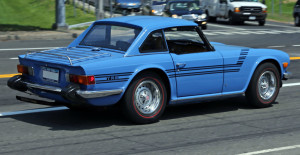The History of Racing Stripes and Some Interesting Facts

By Mr.choppers (Own work) [CC BY-SA 3.0 (http://creativecommons.org/licenses/by-sa/3.0) or GFDL (http://www.gnu.org/copyleft/fdl.html)], via Wikimedia Commons
As the name suggests, racing stripes were first applied to cars participating in races, in order to increase recognition. According to some official information, such stripes were applied to the Cunningham team racing cars in 1951.
In the 1960s, the stripes started getting applied to cars apart from the vehicles used in races. They were called go-faster stripes during that period and they were used to achieve the cool appearance of race cars. The hood, the roof of the car and the trunk were the places where the stripes were installed most often.
Until the 1960s, vehicles competing in Formula 1 and other major events came in specific colors and with specific stripes to differentiate one team from another. This approach was popular until sponsorship entered the world of racing and the color differentiation became redundant.
Cunningham team cars were distinguished by the two parallel blue stripes passing through the middle of the hood, the roof and the back of the car. The stripes were brought to the scene once again in 1996. This year is often seen as the revival of racing stripes because these were used on a Dodge Viper GTS.
In the 1990s, stripes became widely available as a tuning material. All the traditions connected to their past and the clean, linear appearance give cars with stripes a slightly retro appearance that is very different from the effect that can be achieved through the usage of other tuning materials.
The material that is most commonly used in the production of stripes and stickers today is vinyl. Vinyl managed to beat other materials in terms of affordability and durability. Although thin, it can withstand environmental influences for many years. Good racing car stripes can remain in excellent condition for a period ranging between five and seven years.
Stripes are available in many colors and they can be applied on nearly any part of the car. The traditional application on the front or the sides of the car is still possible but some new options have emerged, as well. Stripes can be applied on the spoiler, the bumpers, the grill of the car or anywhere else that the owner of the vehicle wants to achieve customization.
The traditional shape of the racing car stripe is changed, as well. Although the typical stripes are still available, the range has expanded significantly.
Stripes can come in the shape of flames, detailed ornaments or even lines of lettering.
Some car manufacturers have developed their own stripe ranges as a range of official accessories and tuning products. These ranges are designed for application on a specific model, which has further increased the simplicity connected to the usage of this particular tuning material.
Stripes can also come with distinctive finishes and effects that make them even funkier and more unusual than the original racing stripes that came into existence in the 1950s. Although the style is still the same, the stripe can now look original and somehow modern.
The history of stripes is quite interesting. The origin of this tuning material is easy to understand. What started out as a practical method of distinction has now turned into a wonderful way for the transformation of a car’s exterior. Racing stripes have been around for some time and they are probably here to stay. Although trends in the tuning realm change all the time, the stripe has managed to stand the test of time.
